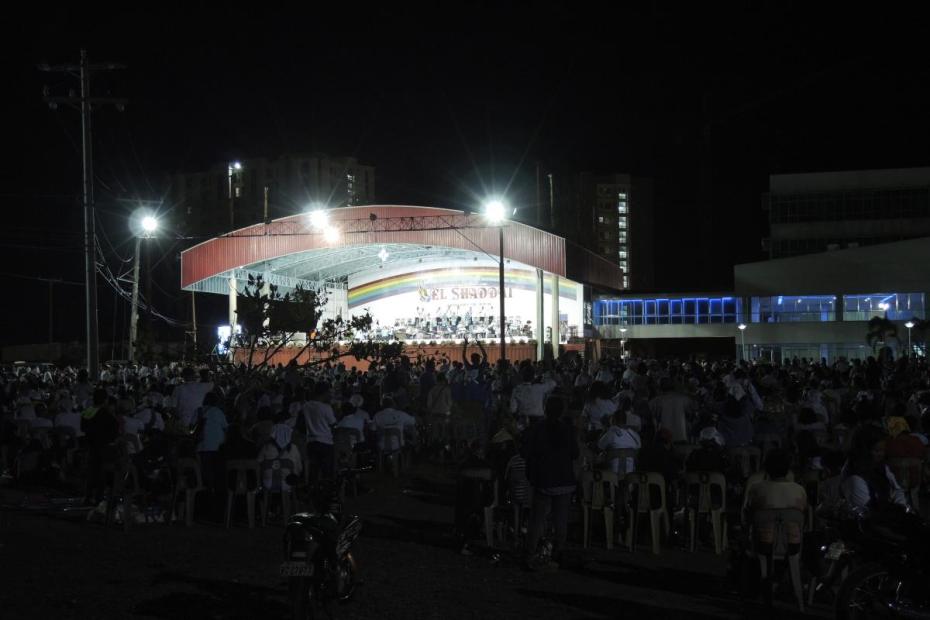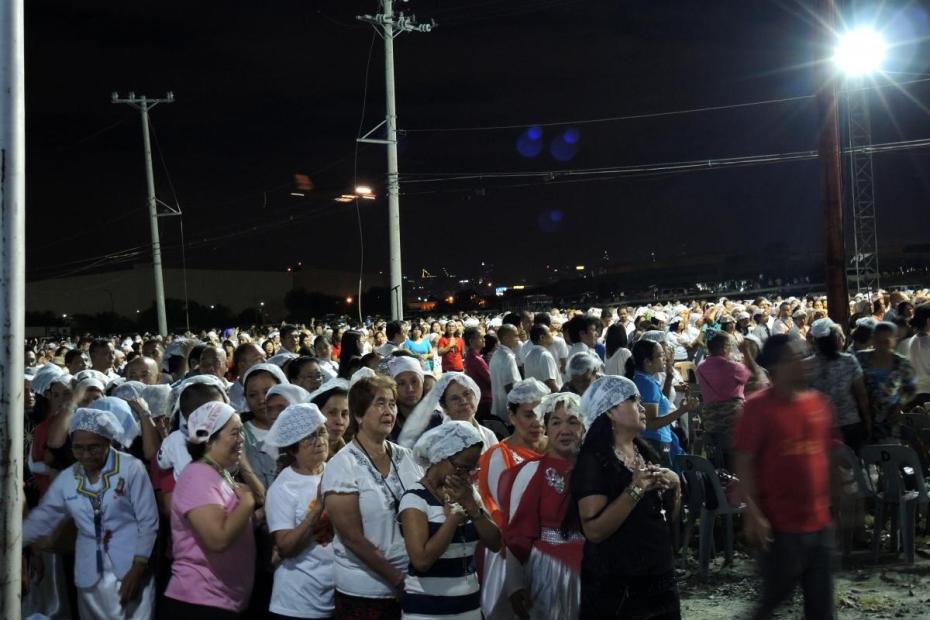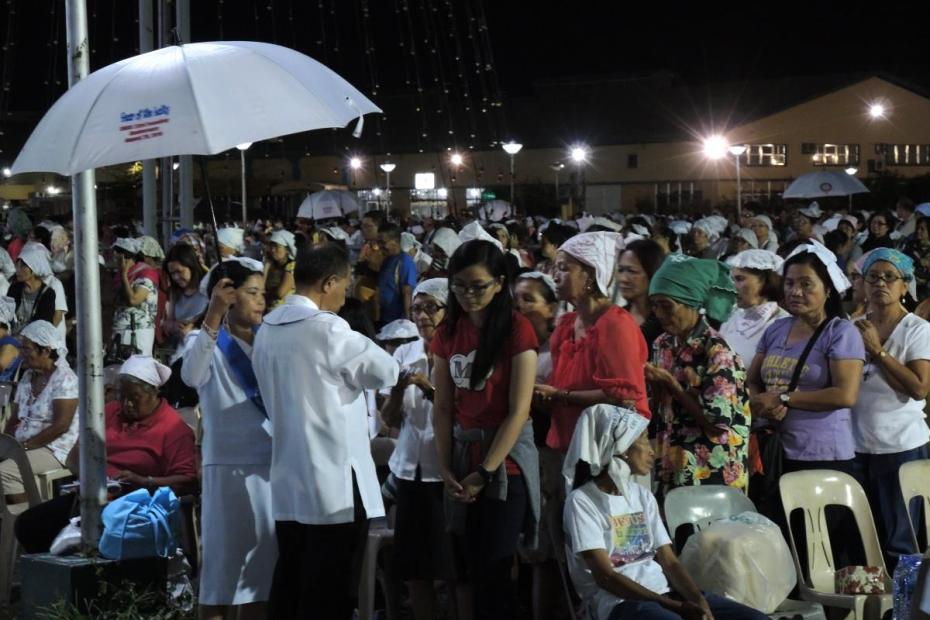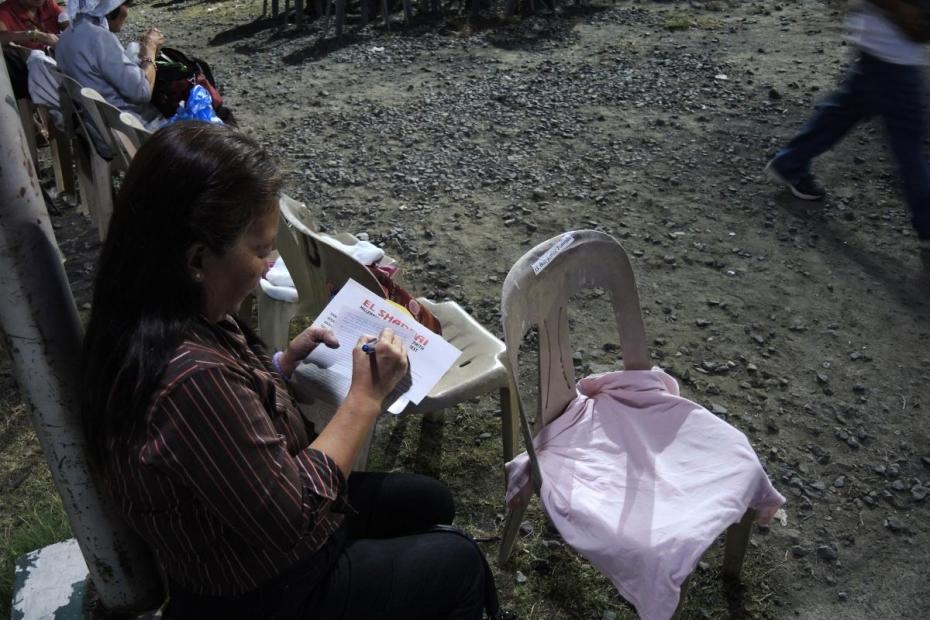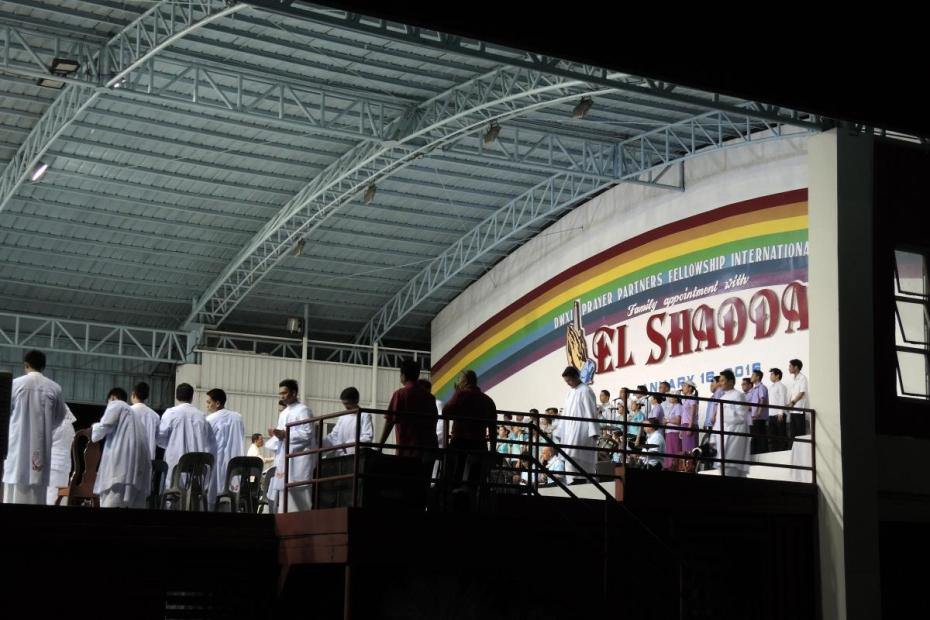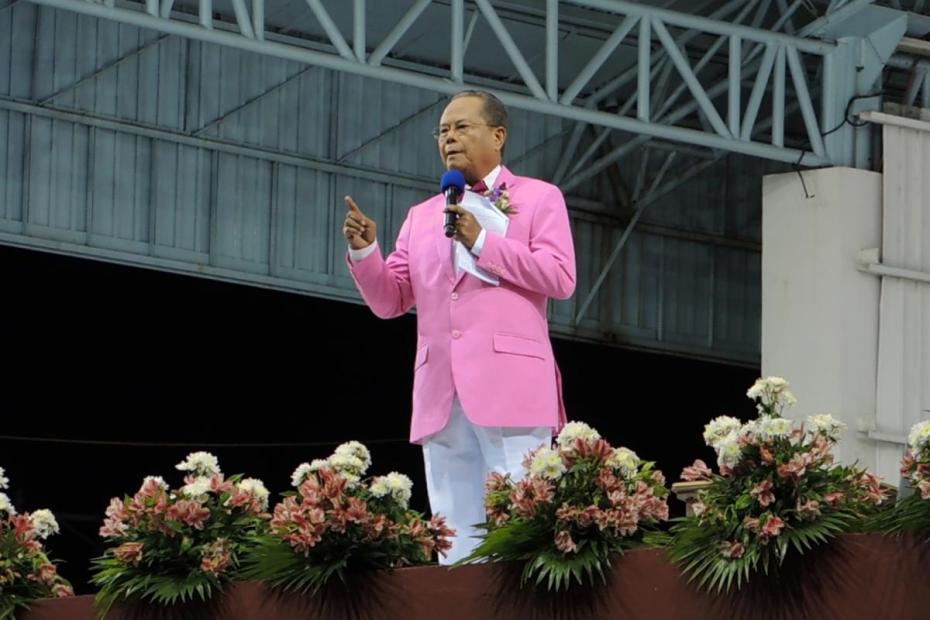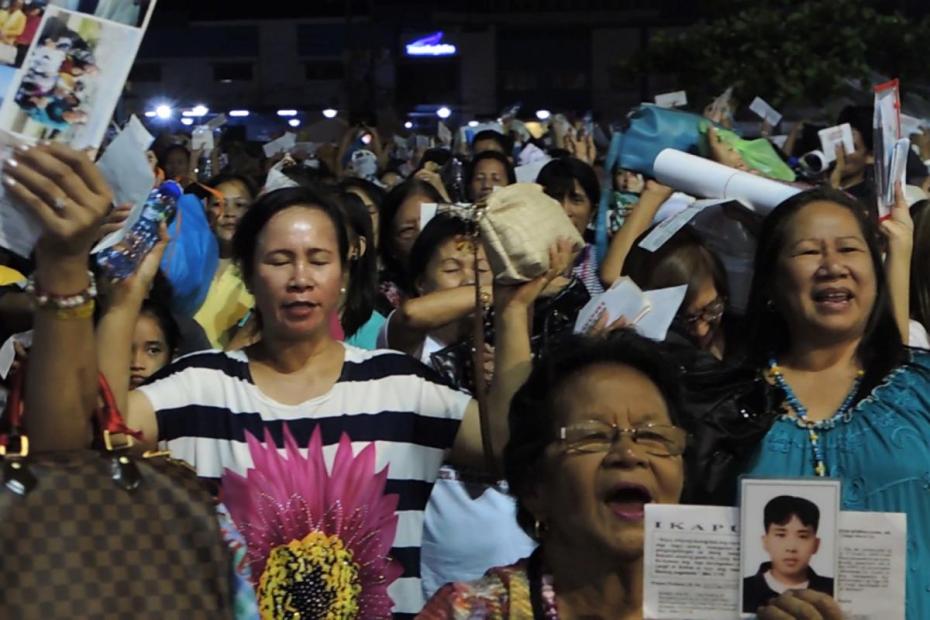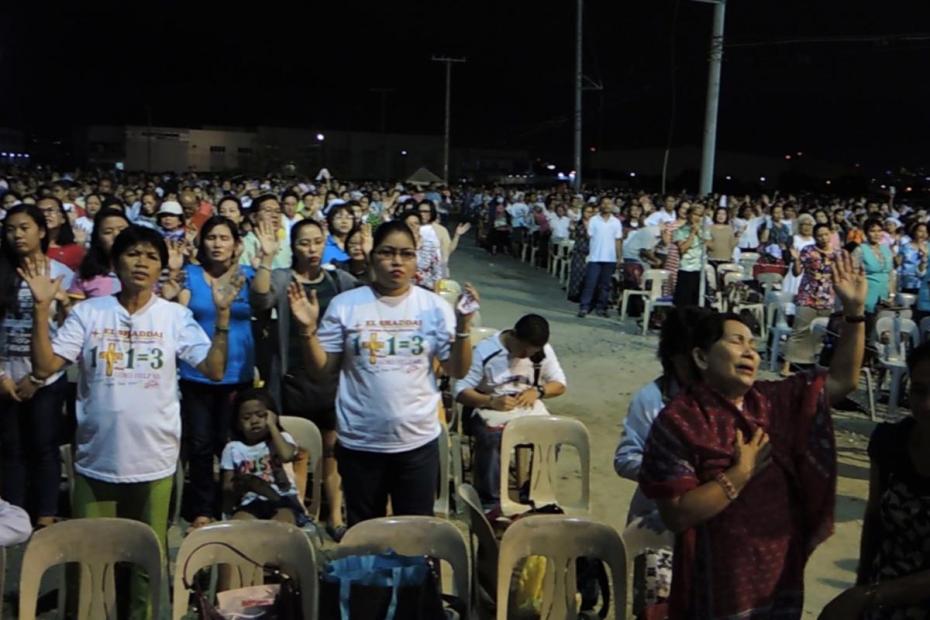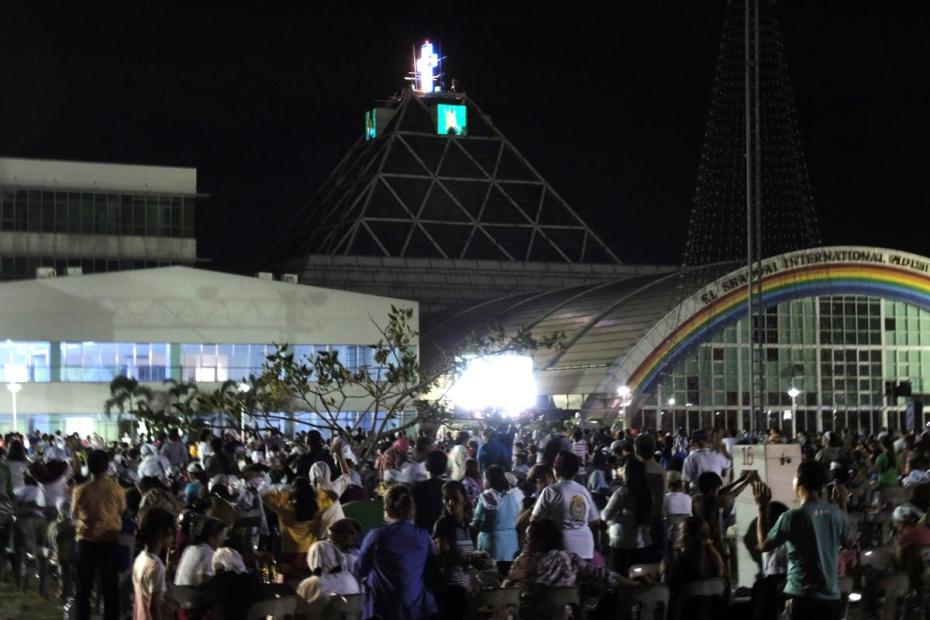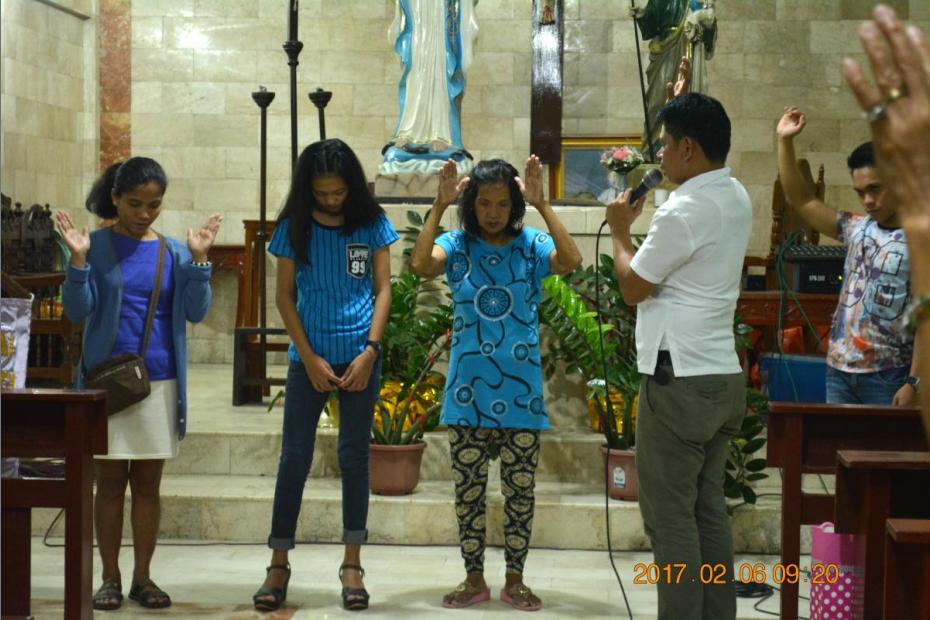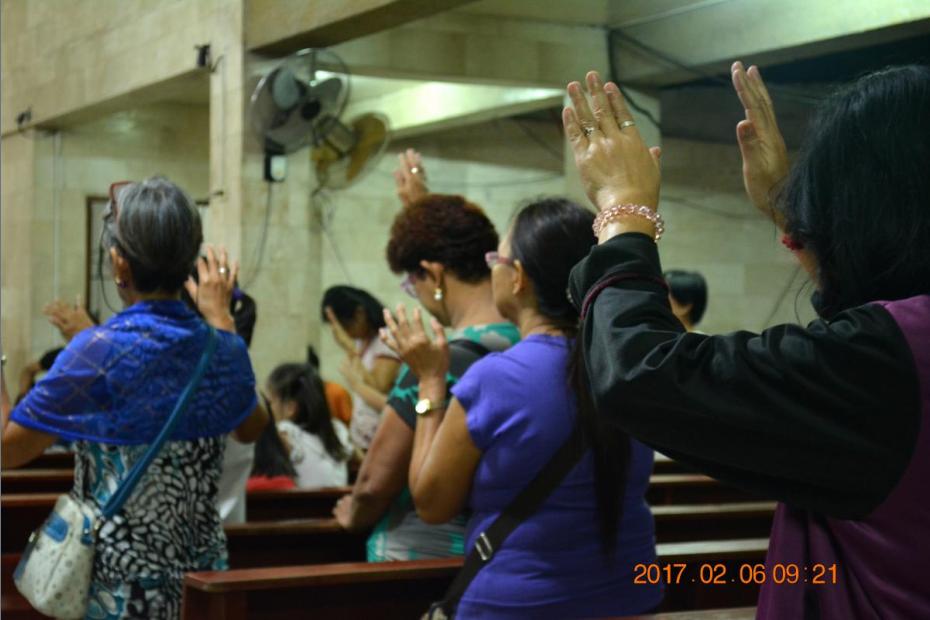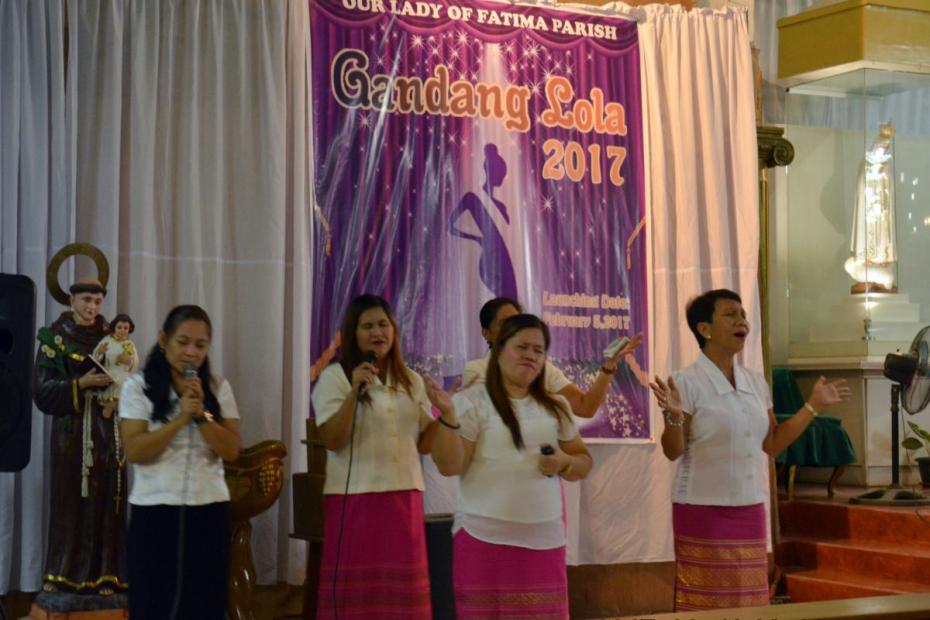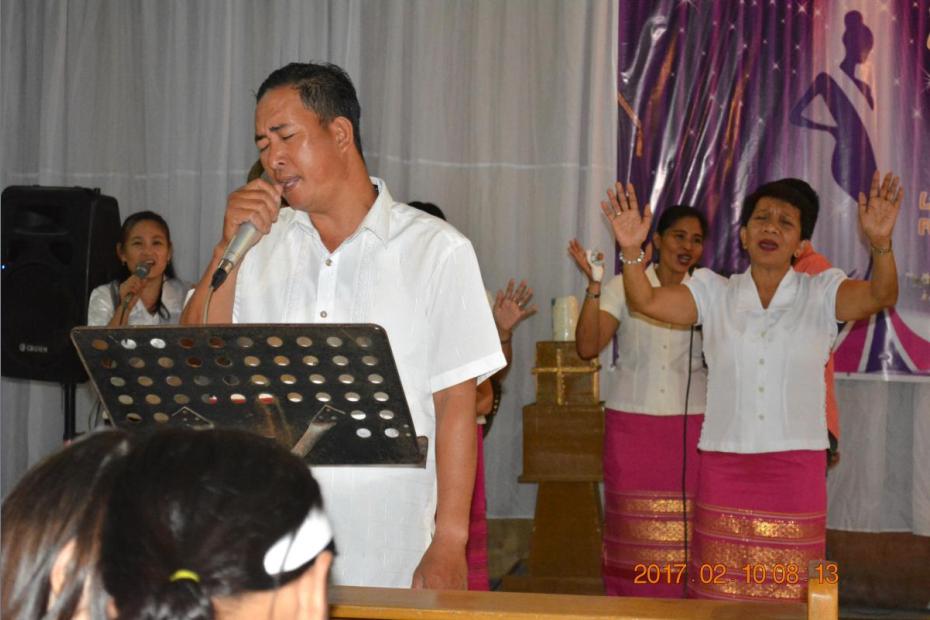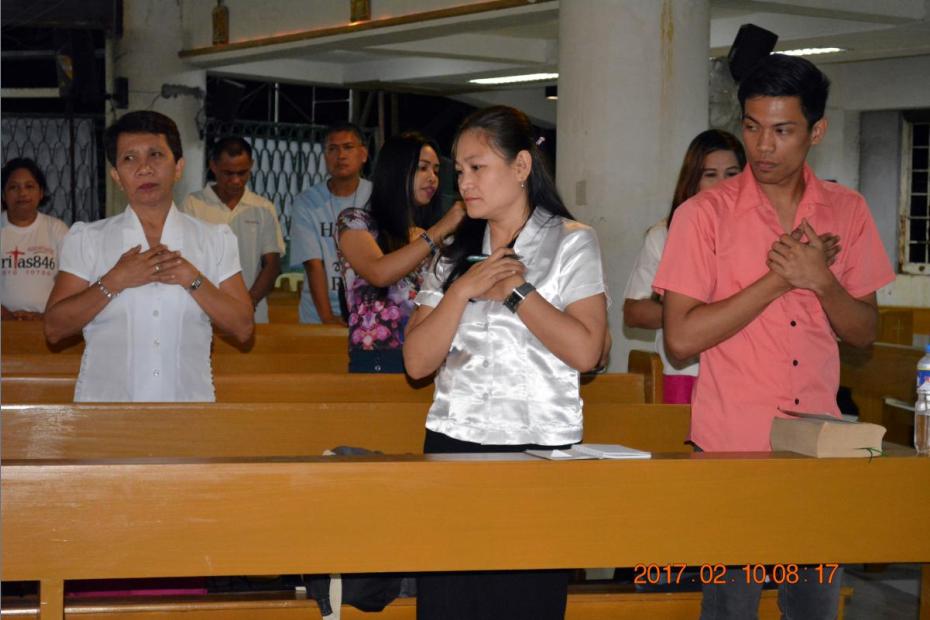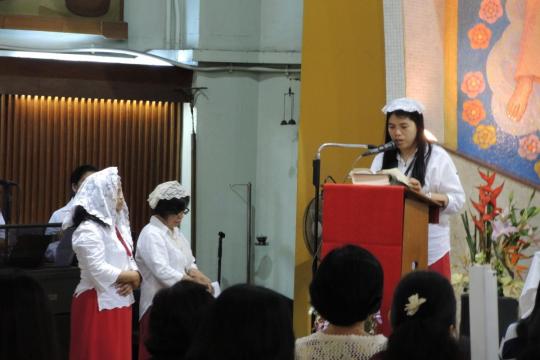Every Saturday evening in Manila, Philippines, on a huge plot of land near the airport, “Brother Mike” Velarde, a married, lay, Filipino real estate baron and “servant leader,” draws vast crowds of believers for a weekly El Shaddai prayer service. Founded by Velarde in 1981, El Shaddai, which claims 9 million members in the Philippines — more than 10% of the country’s Catholic population — and 2 million more among the expatriate Filipino community, is undoubtedly the largest lay Catholic organization in the world.1 In its worship, theology, and aesthetic, El Shaddai often seems more like the Filipino version of an American Evangelical Protestant mega church than a traditional Catholic lay organization, and Velarde often looks and talks more like a Pentecostalist preacher and businessman than a Catholic lay leader. Nonetheless, the movement is linked to — and approved by — the Catholic Church, though not all of its worshippers are Catholic.
These services, well organized rallies that last four hours, are held on a high, brightly lit stage.2 As at most El Shaddai events, the great majority of members are women, often middle aged and older, though they often come with family. They range from the working poor to the middle classes. Most attendees arrive in groups, often having come together with members of a local El Shaddai small community fellowship. The services include a Mass, often with a bishop-celebrant, but it is probably fair to say that the high point of the hours-long services comes when Brother Mike, in an electric-colored sports jacket, arrives to preach. A master of charismatic spectacle, Brother Mike preaches a message to his followers to expect miracles of healing, financial success and transformation in their lives if they put their trust in God and live out his Word. TV and radio broadcasts bring the event to millions who cannot attend in person. El Shaddai’s members, almost all Filipino but scattered throughout the country and in Filipino communities abroad, also meet weekly in smaller faith groups, and tithe at least 10% of their income to the organization.
El Shaddai Fellowship Service, Manila, 2016.
Observers of Catholic lay movements worldwide typically focus attention on European-centered lay movements founded in the 20th century, but in terms of sheer numbers, El Shaddai, which has an entirely different pedigree, almost certainly outnumbers the total membership of all those European-based movements.3 In the Philippines, the movement has undoubtedly challenged the Church to adapt in ways it might not have otherwise, kept some Catholics in the Church who might otherwise have left for Evangelical churches, and has even become a force that presidential politicians regularly court for support and legitimacy.
Stories that serve as El Shaddai’s foundation
The story of Brother Mike, as he relates it, serves as a template for the movement and the hopes and expectations of those who join it. According to Velarde, in February of 1978, as he lay in a hospital bed awaiting a major heart operation, an angel of God roused him and delivered the Word of God to him, reinvigorating his failing heart, and immediately restoring his health after a long period of illness. At the turning point in what he describes as a previously wasted life, Brother Mike became a “born again” Catholic.4
Brother Mike also likes to tell a story of God saving him from financial ruin, when his real estate business was nearly bust: trusting God, he offered his last PHP50,000 (about US$1,000) at a Charismatic Mass and Healing Rally at Araneta Coliseum. Out of nowhere, a group of businessmen went to his real estate office to buy PHP60 million worth of lots with an advance of PHP5 million. Brother Mike came to see, he said, that God would reward many fold those who trusted in him and were generous with what little they had.
He acquired a radio station, DWXI, and launched a program entitled “To God Be the Glory” that aired Sundays from 9 to 11 p.m., but subsequently changed it to El Shaddai. On its first anniversary, in 1984, he invited radio listeners to come over for a Thanksgiving Mass to thank the Lord for all the blessings he had showered El Shaddai. Nearly 1,000 people came to radio station DWXI at the Ninoy Aquino International Airport. As the story is recounted, almost all who came for the healing rally received unexpected cures and blessings. Because of that, people kept coming, forming the basis of El Shaddai that mushroomed into a huge movement. By the 1990s, El Shaddai had millions of members.
The fellowship – Saturday’s 'family appointment' with El Shaddai
Each Saturday, thousands of jeepney buses and other forms of transport converge at a huge El Shaddai campus at Amvel Business Park, near the airport, for the weekly gawain, or fellowship service. Though El Shaddai has built a 15,000-seat worship center on the property — a glass pyramid-topped conference hall called the International House of Prayer that El Shaddai claims is the largest building for worship in Asia — the gawain is held outside to accommodate the crowds, and attendees gather on folding chairs and mats in a huge field surrounding a large, high stage, brightly lit for the television cameras that record the services.
The services interweave traditionally Evangelical and Catholic forms of prayer and worship. They begin with spontaneous prayers, praise and worship songs, and dance. Worshippers clap their hands, sway, and wave El Shaddai handkerchiefs, white cloths printed with the name “El Shaddai” and Psalm 91, often used by women as head-covering kerchief at Mass.5 On stage, a number of members share patotoo, living testimony, about their experiences of God in their lives. After more praise and worship songs, members pray the Angelus, a traditional Marian prayer, sing the Our Father, and recite Psalm 91. A concelebrated Mass, led by Bishop Ted Bacani or by other priests who serve as spiritual directors to El Shaddai, takes place at the halfway mark of the evening services. Mass is followed by more praise and worship songs, and a warm-up to the event that, whatever one might expect theologically, is the main activity of the evening, judging by the energy and emotion. Before Brother Mike’s arrival on stage, the congregation sings the El Shaddai song, the movement’s theme song.6 Then Brother Mike takes center stage, always in an electrically colored jacket, and offers a prayer of praise and worship, of thanksgiving for the whole of creation, and for healing for all of the sick. Songs are sung in Tagalog and English to mark the reading of the Holy Scriptures.
Brother Mike, who employs call-and-response style preaching throughout, follows the scripture reading by asking his audience, "Kumusta na kayo? How are you?" and gets a loud response. A vivid storyteller, he then begins telling stories based either on his own experience or stories others have shared with him, incorporating bits of Filipino folk wisdom. A typical sermon might address the situation of Filipino families, remembering when young people ritually offered signs of respect to elders, and discuss how families are changing. Rather than framing himself as a culture warrior against modernity or contemporary mores, he tries to offer hope and ways forward, linking his stories with the biblical passage that opened the session. He cracks jokes and sings. The sermon would call the assembly to find ways to respect their elders, to remember that when you love your parents, you love God and you put into practice the meaning of the love of God. A relentlessly positive message encourages believers to look at all the ways God is present and working to bring better things in their lives.
At the middle of his preaching, he asks the congregation to hold up their tithes and “love offerings” (additional donations beyond the 10% tithe) in the envelopes dedicated for that purpose. “Prayer requests” are always placed in the same envelope, and as they are held up, Brother Mike blesses them.7 To close, he makes the congregation repeat the theme of his healing message with a “prayer partner.” Normally, he asks people to repeat his “new mathematics” — one plus one equals three. While communicating a belief that people’s generosity will be multiplied in miraculous ways, he regularly says that it means that in everything we do, God is always there. To close, the choir and people sing a song of thanksgiving.
The many El Shaddai followers who cannot attend the fellowship have a variety of opportunities to listen over the radio, watch a delayed telecast on TV or even watch it live in the internet. The aesthetics of El Shaddai differ from ordinary Catholic ones in numerous ways. The location, in a business park next to the airport, where planes take off and land in sight of the proceedings, speaks to modern aspirations and a better future. The size of the crowds, and the presence of television broadcasts, reassures believers that they are part of something big and important.
Fellowship in small groups
On a weekday evening, El Shaddai members typically meet in parishes in small fellowship groups of up to 20 people, also to sing, witness, share faith and read the Bible.8 Weekday Bible services are also held in individuals’ homes. At those services, groups take up a special collection to help each other when crises arise. “We put a contribution into a fund, and whoever needs it, we vote to give it to them,” said one member. Most parishes welcome these groups, but some pastors, wary of El Shaddai, do not allow them to use church buildings.
The meaning of El Shaddai to ordinary members and preachers
Members’ stories about how they came to join El Shaddai typically begin with some story of crisis in their lives.9 According to interviewees, members usually first attend El Shaddai during some moment of crisis — health scares, loss of a loved one, financial problems, or family difficulties. Those who do approach and join are typically middle age or older. A friend, neighbor or relative, recognizing their situation, often brings them, or sometimes they have heard or seen El Shaddai broadcasts on radio or TV. They are drawn in, they say, by Brother Mike’s “healing message of hope.” The name El Shaddai, they are taught, and often repeat, means “a God who is more than enough,” a God who they can trust wants to help and be with them in their daily lives, and to be generous to them. They say that the movement allows them to really connect to the Word of God, and to realize that their problems — financial, career or work-related, marital, with relatives, neighbors and friends — are not insuperable.
Middle-age and older members of El Shaddai often described the encounter with the movement as a new beginning for them, a wake-up call from all the mistakes and hardships they went through before in their lives. Before joining the community, most of the respondents say they were involved in vices, arrogant behavior, and a life without God, but that El Shaddai made them grasp the deeper and true meaning of Christian life, making them God-fearing individuals.
Younger members of El Shaddai, especially teenagers engaged through its youth ministry, don’t necessarily tell these conversion narratives, but see El Shaddai as their way to become closer to God as a friend and as someone whom they could discuss any problems in their lives, whether school-related or with their parents, siblings, teachers and classmates. As one student put it, El Shaddai makes her feel relaxed and blessed.
Despite the conversion narratives, spending time with El Shaddai members makes clear that their lives as members are not idyllic. Life challenges persist among members, and they will sometimes talk about (or display) instances of jealousy, envy, and back fighting. But they still see attendance in El Shaddai as a way to hold on during the most trying moments of their lives and to gain the wisdom in life through the Word of God. They say that they are much better off in the fellowship than out of it, and the more they attend the fellowship, the more blessings they receive. They say that they feel at peace in the midst of all the challenges.
Lay roles and leadership
The Catholic hierarchy has an advisory role to the movement, most closely through Bishop Ted Bacani, a warm and accessible “retired” bishop who has been given this role by the Cardinal. Brother Mike says that he defers to the Church on dogmatic issues, but hardly focuses on these in any case.
Nonetheless, at age 77, Brother Mike remains the head of El Shaddai, assisted by a group of “disciples” that includes family members. He and the disciples choose men from among the members to serve as lay preachers, training them at an El Shaddai-run “College of Divine Wisdom,” where they study the Bible and are taught evangelization methods, counseling skills and how to heal by praying over of hands. These preachers are assigned to preach at small gatherings in the Philippines and abroad, and receive a stipend for doing so. Each small group has a “coordinator,” responsible for local organization and finances, operating along guidelines from the center, and the coordinators are always women. In addition to many lay employees who keep the organization and its media network functioning, volunteers serve in a range of capacities. Some distribute chairs or manage traffic at the Amvel compound during the gawain, or clean the grounds afterwards. Women serve as lectors and ushers during the gawain, and set up for Mass. They also assist in outreach programs. Men and women assist as lay ministers during communion, assist and prepare candidates for adult baptism, confirmation, and at El Shaddai liturgical events. Those with communications skills help prepare newsletters and the El Shaddai magazine. Some lawyers offer free legal clinics, and doctors and dentists offer medical clinics.
Prosperity Gospel of El Shaddai
The prosperity Gospel preached by Brother Mike stands in contrast to the message from the larger Filipino Church, which traditionally included cautions against worldliness and enchantment with material things, and, in keeping with its Spanish legacy, emphasized sacrifice. Late 20th century liberation theology, influential in the Philippines, presented a very different perspective on wealth, and mainstream Catholic perspectives on social justice are hardly in sync with El Shaddai’s preaching. Members are aware of the contrasts, and counter that the prosperity Gospel is appropriate because as children of God we are the caretakers and the stewards of everything that God entrusted to us. “God has more than enough, and God wants us to have an abundant life.” First and foremost, they say, in an echo of church teaching, the abundance in life has to be enjoyed by all. It has to be shared with others. Further, a prosperous life could only be attained by living the Words of God in everyday life, and that requires that the prosperity that we have be shared by giving services, talent, money, time back to others. “This is the secret of prosperity in life — to give back a portion of what God has given to us and to share to others what we can willingly share to them,” said one member.
Tithing, though not a practice normally asked of Filipino Catholics, is not controversial among the members, but is understood as a practice with a biblical foundation — a practice that will be rewarded with blessings from God in this life. In reality, most of the interviewees said that they are not yet capable of giving tithes or love offerings regularly (many envelopes at the gawain apparently contain prayer requests without much money), but that they are all determined that they will surely do once they are financially able. Interviewees trusted that the money would be spent on evangelization and for the sustenance of El Shaddai, and appreciated the opportunity to help others in their small fellowships. Some pointed out that part of the Saturday offerings are given to squatters, and to ministry in the national prison, where El Shaddai preachers visit, and bring items like soap and toothpaste, and where small fellowship groups are forming. Teenagers described tithing as a way to be more blessed financially, believing that once you give, the more you will receive. The love offering for them was described as a way of sharing what they have.
For all this, if the larger Philippine Church has not adopted El Shaddai’s worship style or theology, it has often made its peace with the movement, even though the movement has its detractors. There is some evidence that El Shaddai has been influential in the church at large in one way: most priests may not sing and entertain the way El Shaddai preachers often do, but they are more likely to adapt storytelling and to make homilies more accessible and down to earth, to capture an audience that sometimes needs to be creatively engaged to show up.
Read more
Katherine L. Wiegele, Investing in Miracles: El Shaddai and the Transformation of Popular Catholicism in the Philippines. Honolulu: University of Honolulu, 2005.
Katherine L. Weigele, "Mediated Spaces of Religious Community in Manila, Philippines," in Mediating Faiths: Religion and Socio-Culture in the Twenty-First Century, edited by Guy Redden. Farnham, Surrey, UK: Ashgate, 2011.
Wostyn, Lode, "Catholic Charismatics in the Philippines" in Asian and Pentecostal: the Charismatic Face of Christianity in Asia, edited by Allan Anderson and Edmund Tang, Oxford, UK; Costa Mesa, Calif; Baguio City, Philippines: Regnum, 2005.
Mariano “Bro. Mike” Z. Velarde, With El Shaddai Miracles are Forever: 25 Years of Faith, Love and Unity. Makati, Philippines: El Shaddai DWXI PPFI, Inc., 2009.
- 1The formal name of the organization is El Shaddai - DWXI Prayer Partners Foundation International. DWXI refers to the radio station that launched Velarde’s ministry, PPFI to the foundation that supports it. In her book length study of El Shaddai, based on fieldwork in 1995-96, Katherine Wiegele notes that “even the most conservative estimates” number El Shaddai’s “following” at 9-11 million people. Katherine L. Wiegele, Investing in Miracles: El Shaddai and the Transformation of Popular Catholicism in the Philippines (Honolulu: University of Honolulu, 2005), p. 4. Data on the number of members were provided to Esmeralda F. Sanchez by the managers of El Shaddai’s membership ID System, Amorsolo, Makati, Philippines January 25, 2017.
- 2Rallies used to last six or more hours but have been shortened in recent years due to Brother Mike’s health.
- 3An example of that Eurocentric approach is Massimo Faggioli, Sorting Out Catholicism: A Brief History of the New Ecclesial Movements (Collegeville, MN: Michael Glazer, 2014).
- 4Katherine Wiegele cites an alternative account by a priest who once worked with Brother Mike Velarde early in the movement’s history, who claimed that Velarde told him that it was the 700 Club, American Evangelical Pastor Pat Robertson’s TV program, that converted Velarde. Velarde’s methods, fundraising, terminology and prosperity theology certainly seem to emulate the model of the 700 Club and the methods of other American Evangelicals. Investing in Miracles, 18-26.
- 5This is a particular habit of El Shaddai members. Women do not typically wear veils or head coverings at Mass in the Philippines.
- 6The song, by authors Michael Card and John Thompson, is the same one made famous in Evangelical Christian circles by the American Singer Amy Grant in 1982.
- 7Donors write their names and membership numbers on the cards, but bring all large gifts to the cashier, who gives a receipt. The term “prayer request” is used specifically for prayers that accompany donations, linking the giver’s generosity to God’s.
- 8Collections taken at these events cover a stipend divided among the meeting’s El Shaddai-assigned preacher, the parish church, El Shaddai headquarters, and the chapter, for its own costs.
- 9Comments here are based on participant observation fieldwork by Esmeralda Fortunado Sanchez from 1998-2003, and intermittently since then.
